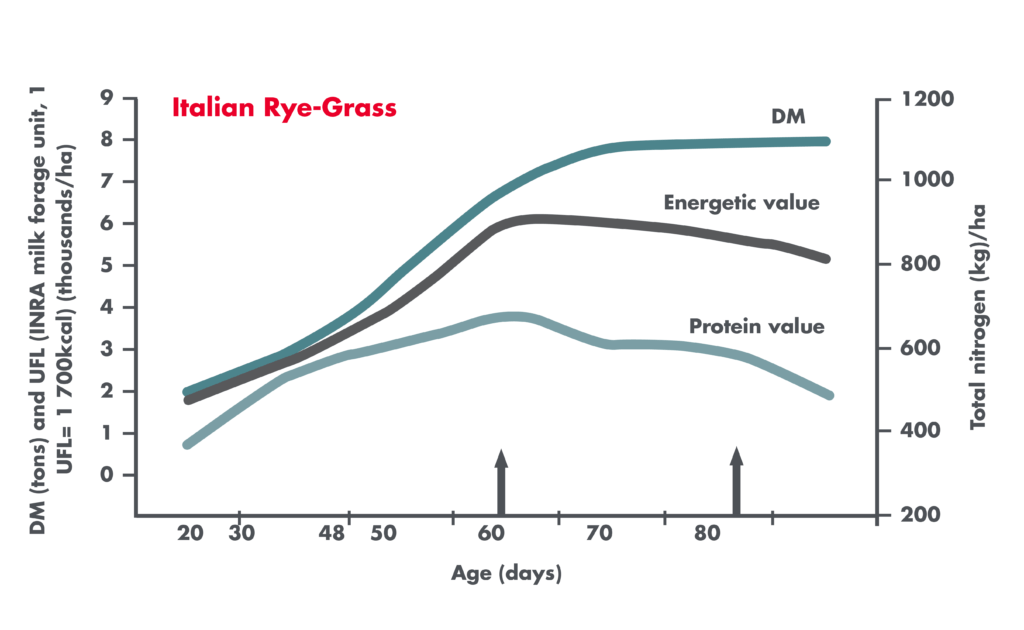Grass may be the most versatile forage crop available to producers. High-quality grass silage is usually grown on more favorable fields with varieties capable of producing quantity and quality. The fermentation process in grasses is not too different from other crops, like corn or alfalfa, but there are some particularities during the harvest.
The variety chosen to ensile should consider factors such as conservation and seasonal availability for grazing.
Maturity
Yield and quality are major factors to consider when harvesting grass. Yield increases, and quality lowers with elevated maturity. Grasses should normally be harvested at the boot (pre-heading) stage, with at least 10% water-soluble carbohydrates. Most forage grass loses quality very quickly after heading, which gives the adage “when you see the head, the quality is dead.” Since the second, third cuts do not have heads, it is advisable to cut the grass by height rather than days or stage of maturity, between 12 to 15 inches, or 30 to 38 cm., tall.
If there is a large area or field of grass to harvest, all at about the same maturity, it may be necessary to start harvest several days prior to the late boot stage. This will sacrifice some yield but should result in higher forage quality. Grass mowed prior to heading often grows better following harvest than when it is allowed to head out.
With alfalfa-grass stands, the field should be managed according to the maturity of the alfalfa. Only when grass represents more than 50% of the stand should the crop be harvested according to the maturity of the grass.
Evolution of quantity of dry matter vs. protein and energy value of Italian ryegrass
Dry Matter
Grasses can begin to lose sugars soon after they are mowed, and sugars are the food of fermentation bacteria. The key to high-quality grass silage is to dry the crop to an appropriate dry matter (DM) level for ensiling as quickly as possible.
| Harvest Stage | DM Level % | |
|---|---|---|
| Silage | Early heading | 28-35% |
| Wrapped Bales | Early heading | 45-55% |
If the grass is ensiled too dry, it makes proper packing difficult. The chance of molding and aerobic instability rises. This can diminish the amount of protein available to the animal. It is important to wilt to the appropriate DM level prior to ensiling.
Chop Height
The cutting height recommendation is slightly higher for alfalfa, at 3.5 to 4 inches, or 9 to 10 cm., since grasses store energy in the base of their stems instead of the roots. Additionally, taller cutting heights reduce the contamination with soil.
Above 30% DM, do not cut more than a 0.5 inch, or 1.5 cm. This chop height requires good control of the fiber efficiency and fermentation process. Below 30% DM, there is less risk of spoilage, and a higher chop length could be used — between a 0.75 inch to 2 inches, or 2 to 5 cm.
Mowing
Leaving the mowed forage in wide swaths will result in faster drying and better conservation of plant sugars. Grass crops can have lower sugar concentration than corn, so conserving plant sugars is important.
Cutting grass in the afternoon following a sunny morning results in higher forage sugar levels, but much of these sugars are lost if the forage remains in the windrow overnight. For best results, cut and harvest within a single day. Wilting times vary depending on the variety and weather conditions.
Challenges
Soil, or ash, contamination is common in grass silage. Excess ash can boost the risk of impaired fermentation and spoiled silage. Producers should aim to keep ash content below 10% DM for grass silage by:
- Planting varieties that stand better
- Harvesting earlier
- Raising the cutter bar
- Using flat knives
- Keeping the windrow off the ground
- Keeping rake tines from touching the ground
- Minimizing movement of grass horizontally
- Using a windrow merger
- Storing silage on a concrete or asphalt base
Due to its lower sugar levels, spoilage on the face of grass silage is usually less of a problem compared to corn silage. However, butyric acid formation in low DM forages is a greater problem when forages are left in the field overnight.
Wheel damage is an overlooked source of plant damage in the field. Avoid unnecessary trips across the field and consider using small tractors and avoid duals.
A critical component to high-quality silage is a rapid drop in pH. Grass silage typically can have a higher buffering capacity, or resistant to a change in pH. This resistance is determined by plant components such as organic compounds, soluble sugars, crude protein and cations such as potassium. Therefore, the use of a research-proven forage inoculant is important to creating high-quality silage, especially if the forage has to be ensiled at a low DM level. Click here for more information on inoculant choices.
With high-sugar grass varieties, the sugar acts as an excellent substrate both for fermentation and spoilage organisms. As a result, ensiling and feedout management must be optimal to maximize the potential benefits of these varieties. Increasing levels of sugar is directly associated with inflating levels of lactic acid in the final silage and higher residual sugar levels at feedout, both of which stimulate aerobic instability if the silage is not correctly managed. If there is a history of heating issues, then an inoculant with Lactobacillus buchneri should be used.
Additional Reading
Check out these resources written by silage experts for more information on creating grass silage.









